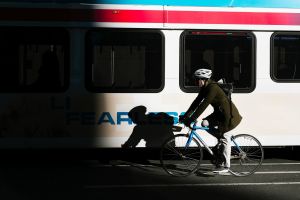A recent poll from the Chicago Council on Global Affairs and The Harris Poll shows urban and suburban residents cities are looking to sustainable mobility to forestall a potential long-term shift to solo driving.
With public transit ridership down sharply during the COVID-19 pandemic, cities are looking to sustainable mobility to forestall a potential long-term shift to solo driving.
Sustainable mobility options such as public transit, cycling, and e-scooters can offer safe, affordable travel to residents. They can make transportation networks more resilient. Significantly, they can also reduce emissions from transportation, the source of about one-third of total carbon emissions in C40 member cities. Because many urban trips are short–in Chicago, half are less than three miles–advocates have long noted the potential for some solo car trips to be replaced with cycling, walking, e-scooters, or the bus.
But how willing are urban residents to replace car trips with more sustainable modes? A recent poll conducted by the Chicago Council on Global Affairs and The Harris Poll surveyed urban and suburban residents in six large US metropolitan regions: New York City, Chicago, Los Angeles, Philadelphia, Houston, and Phoenix. The survey data represent the aggregated responses of residents across these metropolitan regions.1
Key Findings
- Nearly two-thirds (63%) of urban residents (respondents living in the central city/downtown) would consider traveling to work via public transit, far higher than pre-pandemic ridership rates in any of the cities surveyed.
- Among metropolitan respondents (inclusive of urban, inner suburb, outer suburb/exurb, and rural), top reasons for declining to consider transit were COVID-19 (50%), trip time (43%), and personal safety (32%).
- More than half of urban residents (54%) would consider traveling to work via bicycle or electric bicycle, and 48 percent of these residents would consider commuting via electric scooter.
- Among metropolitan residents, distance to work (43%), traffic safety (32%), and personal safety (27%) are the top reasons given for declining to consider cycling to work.
- A large majority of urban residents (77%) support the construction of bike lanes and other infrastructure for bicycles and very small vehicles (e-scooters or e-bikes, e.g.).
- A large majority of urban residents also support building new highways (75%) and widening roads (80%).
Public Transit Can Lure Riders with Service and Safety
In the metropolitan regions surveyed, residents’ professed willingness to commute via public transit far outpaced actual ridership rates.
Overall, 47 percent of metropolitan residents and 63 percent of urban residents said they would consider traveling to work via transit. Yet among the cities surveyed, the actual rate of commuting was far less. According to 2018 American Community Survey (ACS) data, the actual rate of commuting via transit in 2018 was 3 percent in Phoenix, 4 percent in Houston, 9 percent in Los Angeles, 26 percent in Philadelphia, 28 percent in Chicago, and 56 percent in New York City.2
Public Transit: Willingness to Ride vs. Actual Ridership
Respondents' answers of "Would you consider traveling to work via public transit?" compared to actual proportion of commute trips made via transit in cities surveyed.
Sources: Harris Poll, November 5-19, 2020 | n= 1,200; 2018 American Community Survey (US Census Bureau)
Half of metropolitan respondents (50%) unwilling to consider riding public transit named COVID-19 as a reason. Nearly as many (43%) blamed too much time in transit, and one third of respondents (32%) had personal safety concerns. Additionally, more than one quarter (27%) complained about the current level of service in terms of timeliness, frequency, and cleanliness.
Large American transit agencies–and those across the world–are developing strategies to improve safety and service during the pandemic to regain riders. But the survey results may also suggest that agencies can do more than simply recover lost ridership. Even as questions remain about the future extent of remote work, agencies have a large pool of potential new riders who might be lured to transit with improvements to safety, trip times, and service.
Furthermore, by prioritizing racial equity, cities and transit agencies can better meet the needs of the riders who rely most on public transit. For example, research shows personal safety to be a serious barrier to transit use for African-American and Hispanic residents. Solutions tailored to these riders’ needs can help provide high-quality mobility options without the expenses associated with car use.
Cycling (and Scooting) has Unrealized Ridership
Among the cities surveyed, actual bike commuting rates in 2019 ranged from a low of 0.4 percent in Houston to a high of 2.1 percent in Philadelphia. Yet 54 percent of urban residents said they would consider cycling to work, compared to 44 percent in inner suburbs and 25 percent in outer suburbs. Additionally, 48 percent of urban residents said they would consider commuting via e-scooter.
Bicycle: Willingness to Ride to work by Geography
Would you consider traveling to work via bicycle or electric bicycle?
*Metropolitan area includes all four geographies: central city (urban), inner suburb, outer suburb/exurb, and rural
Source: Harris Poll, November 5-19, 2020 | n = 1,200
Across metropolitan regions, respondents who declined to consider cycling to work listed the following reasons: Distance to work (43%), traffic safety (32%), personal safety (27%), and time (23%). Additionally, one in five (19%) stated they would simply never cycle to work.
During the pandemic, many cities bet on infrastructure to encourage cycling, most notably in Paris, where Mayor Anne Hidalgo committed to building 650 kilometers of bike lanes, coupled with a €300 million investment to upgrade the city’s bike network. In the United States, cities such as Minneapolis, Oakland, and Philadelphia followed suit with “open streets” and pop-up bike lanes of their own, albeit on a smaller scale.
Notably, male metropolitan residents were more likely to consider cycling to work (51%) than female respondents (30%).
While physical infrastructure such as bike lanes can play an important role in improving safety and luring riders onto bikes, research has shown the limits of prioritizing bicycle infrastructure over meaningful engagement with communities on their transportation needs.
Many African-American and Hispanic neighborhoods, often ignored and exploited by the city planning establishment, have specific transportation needs and the construction of bike lanes has often served as a symbol of gentrification. Interestingly, the overall unweighted survey results show African-American, Hispanic, and white respondents expressing similar levels of support for bike lanes and other small vehicle infrastructure.
Still, residents’ genuine engagement and involvement in the planning process is essential, and new infrastructure must grow out of a considered, inclusive, democratic process.3
Residents Support Big Transportation Changes
The survey also found residents across metropolitan regions highly supportive of changes to street infrastructure, with urban residents especially supportive. Notably, this support remained consistent regardless of whether the intent of these changes was to facilitate cycling or driving.
Seventy-seven percent of urban respondents–and 77 percent of metro respondents overall–expressed support for building additional infrastructure for bicycles, e-scooters, and other very small vehicles, such as bike lanes.
- 3
On transportation attitudes, see, for example, Chelsie Coren and Kate Lowe, Commuting in Context: A Qualitative Study of Transportation Challenges for Disadvantaged Job Seekers in Chicago, Metropolitan Planning Council(May 2020); Where Do We Go From Here? Breaking Down Barriers to Cycling in the US, People for Bikes, 2019; Melody Hoffman, Bike Lanes are White Lanes: Bicycle Advocacy and Urban Planning (Lincoln: University of Nebraska Press, 2016); Amy Lubitow, Kyla Tompkins, Madeleine Feldman, “Sustainable Cycling for All? Race and Gender-Based Bicycle Inequalities in Portland, Oregon,” City and Community 18.4 (December 2019): 1181-1202.
Bicycle Infrastructure: Support by Geography
Ho much do you support or oppose additional infrastructure for bicycles and other very small vehicles taking place in your city?
*Metropolitan area includes all four geographies: central city (urban), inner suburb, outer suburb/exurb, and rural.
Source: Harris Poll: November 5-19, 2020 | n= 1,200
Surprisingly, urban residents also expressed strong support for very different transportation interventions: construction of additional highways (75%) and widened roads (80%). Urbanites actually supported new highway construction at a higher rate than metropolitan residents overall (75 percent of urbanites, compared to 64 percent overall in the metropolitan region).
Metropolitan and Urban Support for New Transportation Infrastructure
How much do you support or oppose the following taking place in your city? (% support)
*Metropolitan area includes all four geographies: central city (urban), inner suburb, outer suburb/exurb, and rural.
Source: Harris Poll, November 5-19, 2020 | n = 1,200
Why would urban residents support bike lanes, new highways, and road widening at similar rates? The former is a hallmark of sustainable mobility, small scale and inexpensive. The latter are the opposite: expensive, profoundly disruptive, car-oriented, and generative of carbon emissions.
One possible explanation is that many city residents are frustrated with urban travel, and simply want the transportation network to work better, whatever the method.
Perhaps, this indicates support of any new project with the potential to speed up travel. Notably, the question did not ask respondents to consider trade-offs, such as the public cost and environmental impact of various types of new infrastructure.
On one hand, this interpretation suggests enduring support for the program of large-scale highway building that emerged in the postwar era and radically altered US metropolitan development. On the other, it also suggests enthusiasm for sustainable transportation that policymakers can capitalize on. For example, although bike infrastructure projects frequently incite controversy–so-called “bikelash”–the survey data shows a large majority of urban and metropolitan residents supportive of such projects.
Conclusion
The survey results present an image of metropolitan residents –and urbanites specifically– as willing to embrace new transportation behaviors. Urbanites also express support for new transportation infrastructure, whether to support cars or more sustainable modes. The results suggest policymakers have strong public support for ambitious projects to promote sustainable mobility.
Policymakers can also address residents’ reluctance to travel on sustainable modes with initiatives to improve personal safety, traffic safety, and level of service. In many cases, even trip time and distance to work can be lessened by integrating mobility services, allowing for seamless transfers from bus to shared bikes, for example. Moreover, creating healthier, safer, and more convenient public transit service will likely attract riders lost during the pandemic while also benefitting existing riders.
For urban cycling in particular, policymakers have often focused on bike-friendly infrastructure as the key element to encourage ridership. But research also shows the insufficiency of infrastructure alone to effect large shifts in ridership, particularly in marginalized communities. Indeed, the survey results suggest that although some of riders’ concerns can be solved with infrastructure, some cannot. Infrastructure paired with other strategies –such as community outreach, participatory planning, subsidies, or other approaches– may be more fruitful in changing transportation behaviors.
Methodology
This survey was conducted online within the United States between November 5, 2020, and November 16, 2020, among 1,200 adults (aged 18 and over) by The Harris Poll on behalf of the Chicago Council on Global Affairs. The respondents surveyed were evenly divided among six U.S. metropolitan regions: New York City, Los Angeles, Chicago, Houston, Philadelphia, and Phoenix. Respondents self-identified the community type (i.e., central city/downtown [also referred to as “urban”], inner suburb, outer suburb/exurb, and rural) in which they lived. Figures for age, sex, race/ethnicity, education, region and household income were weighted where necessary to bring them into line with their actual proportions in the population. Propensity score weighting was used to adjust for respondents’ propensity to be online.
This online survey is not based on a probability sample and therefore no estimate of theoretical sampling error can be calculated. Respondents for this survey were selected from among those who have agreed to participate in our surveys. The data have been weighted to reflect the composition of the adult population of each metropolitan area. Because the sample is based on those who agreed to participate in the online panel, no estimates of theoretical sampling error can be calculated.
Responses in this survey were tested for statistical significance using a Z-test with a confidence level of 95% and a Z-test with a confidence level of 90%.




